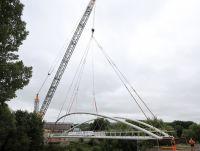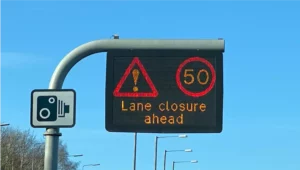The proportion of road bridges managed by councils across Great Britain that are classified as ‘substandard’ has fallen slightly over the past year.
However, 1 in every 24 bridges (4.3%) is still unable to carry the heaviest vehicles on our roads, including lorries of up to 44 tonnes, according to the RAC Foundation.
Many of the substandard bridges are subject to weight restrictions. Others will be under programmes of increased monitoring or even managed decline.
In highway engineering, the term ‘bridge’ encompasses major structures spanning estuaries through to stretches of road at least 1.5 metres in length such as might span a culvert carrying water under the carriageway.
The figures come from analysis carried out by the RAC Foundation with the help of the National Bridges Group of ADEPT (the Association of Directors of Environment, Economy, Planning & Transport).
The analysis is based on responses to FOI requests made by the Foundation in December 2022 to 207 local highways authorities.
The results are based on data provided by 196 councils out of the 207 asked.
Between them, the 196 councils are responsible for maintaining 71,925 bridges, of which 3,090 (4.3%) are substandard.
This compares with the previous year’s figures provided by 196 councils which showed that of the 70,944 bridges they reported as managing, 3,211 (4.53%) were substandard.
Whilst the proportion of substandard bridges is the second lowest since the Foundation started its survey back in 2016 (the lowest proportion was 4.27% in 2018/19), it has remained fairly constant over that period, peaking at 4.6% in 2016/17.
There were no reports of bridges that had fully collapsed, however there were 14 partial collapses.
The 14 partial collapses were in: Aberdeenshire (5), and Barnet, County Durham, Lancashire, Na h-Eileanan an Iar, Shropshire, Tower Hamlets, Warwickshire, Conwy and Newport (1 each).
Between them, councils say they would ideally want to bring 2,506 (81%) of the 3,090 substandard bridges back up to full carrying capacity.
However, budget limitations mean they anticipate that only 387 of these will have the necessary work carried out on them within the next five years.
The estimated cost to bring all the substandard bridges back up to perfect condition is £918 million (down 22% on the £1.16 billion figure of a year earlier).
The study reveals that the one-time cost to clear the maintenance backlog on all 71,925 bridges is £5.861 billion.
The ten councils in Britain with the highest number of substandard bridges are:
| Rank | Local Authority | Number of bridges | Number of substandard bridges | Proportion of substandard bridges |
| 1 | Devon | 2714 | 224 | 8% |
| 2 | Cheshire East | 1047 | 194 | 19% |
| 3 | Essex | 981 | 151 | 15% |
| 4 | Somerset | 1499 | 128 | 9% |
| 5 | Suffolk | 1287 | 119 | 9% |
| 6 | Cornwall | 1009 | 98 | 10% |
| 7 | Northumberland | 977 | 93 | 10% |
| 8 | Gloucestershire | 856 | 91 | 11% |
| 9 | Lancashire | 1481 | 78 | 5% |
| 10 | Aberdeenshire | 1677 | 74 | 4% |
The ten councils in Britain with the highest proportion of substandard bridges are:
| Rank | Local Authority | Number of bridges | Number of substandard bridges | Proportion of substandard bridges |
| 1 | Hammersmith and Fulham | 4 | 2 | 50% |
| 2 | Bristol | 140 | 52 | 37% |
| 3 | Waltham Forest | 51 | 17 | 33% |
| 4 | Kensington and Chelsea | 4 | 1 | 25% |
| 5 | Brent | 40 | 9 | 23% |
| 6 | Conwy | 278 | 57 | 21% |
| 7 | Cheshire East | 1047 | 194 | 19% |
| 8 | North Tyneside | 73 | 13 | 18% |
| 9 | Wolverhampton | 58 | 10 | 17% |
| 10 | Warrington | 231 | 36 | 16% |
A full list of councils is available at the end of this press release, together with top ten tables for England, Scotland and Wales.
The RAC Foundation also asked the national roads authorities about their bridges:
| Number of bridges | Number of substandard bridges | Proportion of substandard bridges | |
| National Highways | 9,390 | 59 | 1% |
| Transport Scotland | 2,627 | 38 | 1% |
| Welsh Assembly | 1,267 | 104 | 8% |
Steve Gooding, director of the RAC Foundation, said: “This latest study shows the scale of the challenge local authorities are valiantly wrestling with to protect the critical road infrastructure we all rely on in the context of huge funding and resource pressures.
“The numbers illustrate how important it is for significant sums of money to be spent tackling at least the higher priority work. Whether it is potholes or bridges there is only so long that councils can continue to patch things up before bigger cracks literally start to appear in the road network.
“One other key finding of the report is the need for local authorities to have a very precise inventory of what they are responsible for – attention to detail is critical on what by any road user’s reckoning must be regarded as critical infrastructure.”
Kevin Dentith, vice chairman, ADEPT National Bridges Group, said: “ADEPT National Bridges Group are once again very grateful to the RAC Foundation for collating this data, it provides the only reliable information we have about the condition of the UK’s highway bridges. The survey focusses on the large number of sub-standard bridges that are on the highway network.
“The term sub-standard generally means bridges are either too weak to carry 40 tonne vehicles or there is a weight restriction for environmental reasons such as a narrow bridge or narrow approach roads. This does not necessarily mean there is a risk to the highway user but it can often cause significant disruption to the free movement of vehicles. The bridge owner will have a procedure in place to manage these structures either by a signed weight restriction or a monitoring system managed by bridge engineers.
“Bridge owners have shown in the data an aspiration to reduce the number of substandard bridges by 81% (over 2500 bridges). The data suggests to achieve this will require government funding of £918 million but there is currently a skills shortage of senior engineers able to take on this work which will also need addressing.”





















